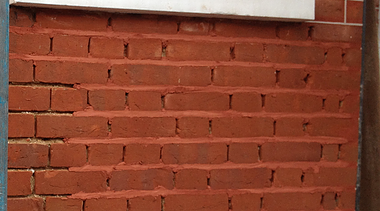Tuck Pointing
Is the brickwork on your property looking tired and worn?
If this is the case, then it is time to act now.
At Brick Restore, our pointing contractors can help with your brickwork repairs in Kingston, New Malden, Sutton and the surrounding areas.
Our repointing specialists can help with our services of weather struck pointing, bucket handle pointing and chimney repointing, depending on your needs.
We offer property maintenance in London at an affordable cost.
The Grand Illusion
The most difficult pointing to execute was and remains is the ‘Tuck joint.’
It was reserved for the use on premier façades of properties to give the illusion that the brick had been cut, rubbed and laid to a superior fine brickwork gauge.
Want your property to look modern and fresh? Contact our experts today to make the first step into improving your brickwork.
All restoration MUST be carried out using these traditional materials and techniques to preserve the fabric that has been admired by many.
Tuck Pointing evolved in England in the 17th Century and became well established by the 18th century. By tradition, it was built using these materials and it was intended as a sacrificial coating to protect the bricks.
If you are looking for a builder who is a specialist in repointing brickwork in Surrey, then contact us today.
The use of a modern-day sand and cement mix on period properties should NEVER be used or considered. This is certain to have a negative effect on the brickwork over time.
The cement would trap moisture inside the brick preventing the buildings from drying; this continuous cycle will eventually lead to the brick chipping down. This is known as ‘spalling.’
However, sand and lime allows the building to breathe, dry out and move naturally as it was originally intended.
Certain complications such as the weather, age and the incorrect use of materials have meant buildings have now become damaged or lost.
If you are looking for brick pointing companies in Surrey, Sussex and beyond, then we are the company for you.
Importance of good maintenance
Lime Mortar is the very fabric that holds your bricks together and should always be kept in good condition.
Unlike cement, Lime is softer and microporous. It lets the moisture evaporate from the joints into the brick or stonework. This allows the masonry to move with thermal expansion.
Deterioration in lime mortar pointing could lead to water ingress and brick spalling. Maintenance to your pointing will help retain the buildings fabric and future value of your property.
The restoration work should be carried out using traditional materials and methods hereditary to the period of your property. The Lime mortar should also always be kept in good condition.
Want to know the repointing brickwork cost? Give us a call today and we will give you a cheap quote.

A Typical example of bricks spalling due to exposed brick joints and prolonged water penetration.
Application Of Tuck Pointing
Tuck Pointing consists of a stopping mortar, made from sand and lime, mixed with Ochre obtaining the similar colour shade to the brick. This is then matured into putty.
A thin levelled and plumbed groove is cut into the mortar which then becomes the ‘housing’ for the lime putty ribbon, which is usually white.
It is then tucked and trimmed to 4-5mm.
When neatly executed, the mathematical appearance and sharp colour gives the desired illusion of strong quality gauged brickwork.
If you are looking for an expert in Tuck & Lime Pointing in Sussex, Kent or Surrey, call Brick Restore Ltd today on 0208 394 29230798 838 7131.


Historical Method of Tuck Pointing
Historically London and surrounding areas had vast amounts of tuck pointing to premier façades.
Due to age, weather and the inappropriate use of modern day materials such as cement based mortars and inappropriate pointing they have become damaged or lost, though remanence can still be found under soffits and window sills.











